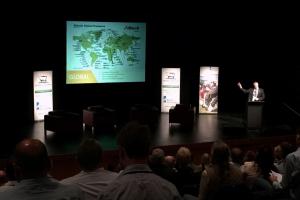Asia: Threat or opportunity?
Australian dairy farmers must embrace change
Born from dairy cooperatives in two small villages in India, Amul has grown to become the largest dairy producer in India by volume, collecting nearly 15 million litres of milk per day. This year, Amul will manufacture more than three million tonnes of dairy feed to keep up with demand for milk, making it the largest cattle feed producer in Asia. The company’s three-fold growth over the past 12 months clearly illustrates India’s position as the most influential dairy producer globally.
Matthew Smith, Alltech vice president of Asia-Pacific, spoke about the incredible growth of India’s dairy industry, sharing his experience working in this and other emerging markets at the Australian Dairy Conference, where speakers from around the globe gathered to share encouragement and ideas about the dairy field.
“As a nation, India’s goal is to produce 200 million tonnes [of milk] by 2020,” said Smith. “While 2014 production was only around 147 million tonnes, it is incredible to think that if every milking animal in the country gave an extra half litre per day, the target could be met tomorrow.”
For many years, milk production in India has been dominated by cooperative systems, in which milk is collected daily at thousands of milk collection centres across the country. In recent years, consolidation and private investment have led to the rapid growth of large dairies that utilise state-of-the-art technology to produce fresh milk.
“It is not uncommon now to see 1,000-cow dairies in the main dairy states of the Punjab, Maharashtra and Gujarat,” said Smith.
“It is estimated that 43 percent of total milk revenue comes from value-added milk in India,” he continued. “With a strong focus on export to the China and Russia markets, India will shape the future of our industry.”
China is seeing rapid consolidation within the dairy industry as well. The number of farms with 1,000 or more cows reached 18 percent in 2013, compared to just 5.5 percent dairy in 2008. Meanwhile, the number of farms with less than five cows fell from 32.4 percent in 2008 to 20 percent in 2013. China is one of the fastest growing markets for milk products globally and the market is predicted to almost double in volume by 2020 from current levels.
This move toward consolidation and the growth of “mega-dairies” prompted Nestlé to open the Dairy Farming Institute (DFI) in Harbin, Northern China. The 600,000-square-metre facility consists of three working dairy farms of different sizes (8,000, 2,700 and 850 cows). Partnering with Nestlé, Alltech participates in numerous educational initiatives and gives assistance in establishing best practices in Chinese agribusiness to develop future farm managers and professionals within the dairy industry.
“Alltech is proud to be Nestlé’s nutrition technology partner, incorporating our In Vitro Fermentation Model (IFM) laboratory into the DFI campus,” said Smith. “Using this proprietary diagnostic tool, we can rapidly evaluate how efficiently a cow will digest a particular ration and make changes to improve feed efficiency, reducing cost and eliminating waste.”
Smith announced that Alltech will be bringing the IFM technology to Oceania (Australia and New Zealand) this year.
“This technology goes hand-in-hand with the launch of our E-CO2 business to help dairy farmers improve dietary efficiency, reduce the carbon footprint and add more value to every drop of milk,” he said. “These tools will help Australian dairy farmers access the value-added export opportunities that exist today.”
Smith stressed that demand for milk in Southeast Asia will keep growing and investment in the region is enormous.
“We only need to look at companies such as TH Milk in Vietnam, one of the largest dairy farms in the world,” he said.
TH Milk, a $1.2 billion dairy farm, applies automated technology from Israel, the U.S. and Europe. Currently, the farm has more than 42,000 cows, of which more than 22,000 are estimated to be lactating at 30-40 litres per cow per day. Such a model requires large scale investment and commitment.
“The massive investment and consolidation happening across the region may be the future of milk production in Southeast Asia, but it won’t impact opportunities for export for Australian farmers any time soon,” said Smith.
He also emphasised the opportunities that come with the huge growth in demand across the region for both fresh milk and value-added milk products, and encouraged attendees to travel to Asia to see firsthand the investment in large operations and new technologies being embraced in the race to keep up with demand for milk.
“We know there is huge demand out there and we know how to add value to our milk products, but we must also understand how we can use new nutritional technologies to better improve efficiency,” he concluded.
Learn more about the 2016 Australian Dairy Conference and speakers here.


